MSc thesis (Completed)
2023
How does secondary forest regeneration depend on the surrounding forest landscape and soil quality? Alba Gimeno
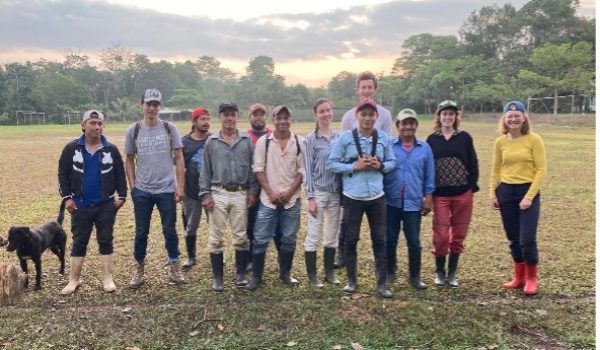
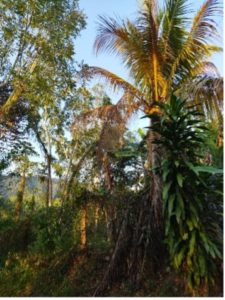
Rationale. Tropical forests are disappearing rapidly due to deforestation and forest degradation. However, secondary forests can regrow once the land is left fallow through a process called secondary succession. Several factors affect different stages and aspects of this regeneration process.
Aims. This study aims to (1) understand the effect of the surrounding landscape in terms of distance to the nearest forest and percentage of surrounding forest cover on seed dispersal and (2) the effect of site factors, such as soil characteristics and plant resources (i.e., light and water) on seedling establishment.
Approach. Fieldwork was conducted in 3 years old abandoned crop/pasture fields in the wet forest region of Loma Bonita, Chiapas, Mexico. Twenty 25x25m vegetation plots with different percentages of surrounding forest cover were remeasured. Trees (≥1cm stem diameter at 130cm height), woody seedlings (<1cm stem diameter at 30 cm height) and vegetation transects were remeasured, and monitoring data from temperature, light and moisture sensors in each plot were obtained. In each plot, four 0.25m2litter traps were established. Litter traps were collected twice (in April and May 2023), seeds were counted and identified at species level.
Findings.
- A higher pioneer forest cover within a 1000m radius around the plot increased seed species richness, indicating that forests at a fairly large radius from the plot are a source of seeds for the regenerating forest.
- Higher tree presence in the plots increased seedling abundance and richness, as well as the number of pioneer seedlings, but did not have any effects on seeds. Thus, these trees do not contribute to seed rain, but facilitate seedling establishment through other mechanisms such as creating favourable microclimatic conditions.
- The percentage of pioneer seedlings increased with the distance to the nearest forest, because surrounding forest attracts biotic dispersers, and pioneers tend to be wind-dispersed.
- Seedling abundance was positively influenced by soil organic matter and negatively by soil nitrogen concentration. The percentage of pioneer seedlings was positively correlated to soil nitrogen concentration.
Implications. Pioneer trees in the land surrounding the regenerating forest promote seed dispersal and the remnant trees facilitate seedling establishment. This suggests that not only old-growth forests are important to conserve to foster natural regeneration, but also young regenerating forests with pioneer species, as well as remnant trees, as they help initiating secondary succession.
Citation. Alba Gimeno (2023). How does secondary forest regeneration depend on the surrounding forest landscape and soil quality? MSc thesis, Wageningen University & Research, Wageningen, The Netherlands.
How does ecosystem functioning recover in early-successional secondary Ghanaian forests? Tijs Kuzee
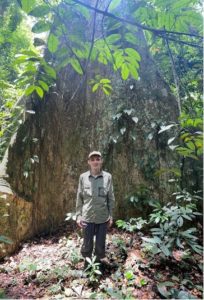
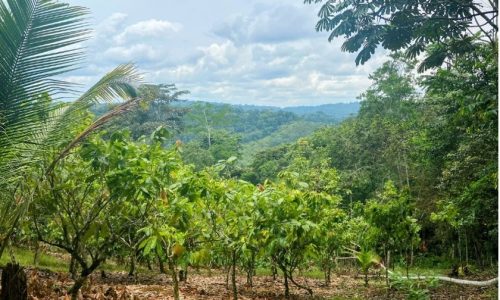
Rationale. Tropical forests are important for biodiversity and ecosystem services, but human activity is converting old-growth forests often for shifting agricultural purposes. When these lands are abandoned, forests regenerate naturally through tropical forest succession. Little is known how ecosystem processes related to carbon sequestration and storage in the vegetation and soil recovery over time and how they vary under different climatic conditions. This is important to know, because forest fallows recover soil fertility and health, and may play an important role in mitigating climate change.
Aims. This thesis aims to understand the development of carbon and soil dynamics in early secondary forests in wet and dry forests in Ghana.
Methods. In Ghana, vegetation recovery and aboveground biomass (AGB) have been collected over the past 3 years in 40 secondary forest plots (25 x 25 m) growing on former cassava and maize plantations. In 2023, I collected 2 months of data on litter production (in 4 litter traps per plot), and soil samples (from soil cores for soil carbon and belowground root biomass [BGB]).
Results & Discussion. AGB increased rapidly over time in both dry and wet forests and total root biomass increased with age in the wet forest, but it did not in the dry forest. Thus, AGB contributes a larger share of the carbon storage than the BGB. Fine root biomass was driven by macroclimate, with the dry forest having a higher fine root biomass compared to the wet forest. AGB increased AGB productivity indicating that larger individuals are capable of photosynthesizing more and thus converting resources into biomass at a greater quantity. However, the increase in AGB productivity did not lead to a significant increase in litter production possibly because of the more developed canopy inhibiting litter production in the understory, or due to a loss of deciduous species in the dry forest—which are responsible for a large portion of litter production—resulting in a lower litter production. Ultimately, the litter production positively impacted the carbon storage in the soil, though there was no significant difference between forest types.
Implications. Secondary tropical forests play an important role in climate mitigation and soil recovery through their ability to sequester carbon into their regenerating biomass and regenerating soil nutrients.
Citation. T. Kuzee (2023). How does ecosystem functioning recover in early-successional secondary Ghanaian forests? MSc thesis. Wageningen University & Research, Wageningen, the Netherlands.
Functional trait recovery in early successional forests in Ghana Thomas Meerwijk

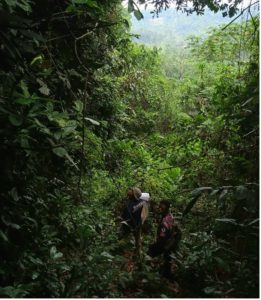
The rationale: Currently, over 50% of all tropical forests are classified as secondary forests and therefore play an important role in carbon sequestration and biodiversity conservation. Secondary forests have the potential to recover relatively fast in terms of biomass, species diversity and functional trait composition. However, the recovery might be limited by a lack of seed input or harsh climatic conditions. Restoration efforts could benefit from a better understanding of how surrounding forest cover limits forest recovery and how plants adapt to harsh environmental conditions during early succession.
The aim: This study aims to understand 1) how wet and dry forests differ in their functional trait composition, 2) how their functional trait composition changes over time and 3) how this is affected by climatic conditions and surrounding forest cover.
The approach: In this study 20 and 19 plots of 25 by 25 meters were set up on abandoned agricultural fields in tropical dry and tropical wet regions in Ghana. Basal area and climatic conditions were measured for each plot throughout the study. For the most dominant species in each plot data on 7 functional traits was collected. Satellite images were used to calculate surrounding forest cover at different radii.
Findings:
- Functional trait composition was mostly determined by regional macroclimate and to a lesser extent influenced by surrounding forest cover and local microclimate.
- Species in the dry region had more conservative growth strategies which help tolerate or avoid drought whereas species in the wet region had more acquisitive growth strategies that help with light competition and fast resource acquisition.
- Some traits in the tropical wet region became more conservative over time likely due to limited light availability under a denser vegetation layer.
- Surrounding forest cover and local microclimate had a limited effect on functional trait composition and only significantly affected 1 and 2 out of 7 traits respectively.
Implications: Functional trait composition differs greatly per region and can be limited by a lack of surrounding forest cover and local microclimate. Therefore, efforts assisting natural regeneration should be site specific to ensure that recovery does not get limited and local communities can benefit from the ecosystem services the forest provides as soon as possible.
Citation. T. Meerwijk (2023) Functional trait recovery in early successional forests in Ghana. MSc thesis, Wageningen University and Research, Wageningen, the Netherlands.
Litter in early-successional secondary forests in Ghana Bas de Wit

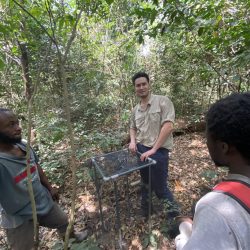
Rationale. Secondary forests play a significant role in ecosystem restoration since they have the potential of fast recovery of multiple forest attributes (e.g., diversity, structure, function and soil). In the tropics, farmers rely on shifting cultivation for their subsistence, and soil carbon and nutrients may recover during forest fallows, due to the leaf litter produced by the regrowing vegetation. Therefore, the soil recovery rate is mainly determined by the amount and quality of litter which are strongly modified by stand structure and species diversity.
Aims. To understand litter dynamics and nutrient flux in very early stages of tropical forest succession in Ghana.
Methods. In a Ghanaian wet region and dry region 40 plots were established on abandoned agricultural fields in 2021, and the vegetation was monitored annually. For this study litter traps were placed in each plot and litter was collected, dried, weighed, and measured for leaf nutrients during dry season (February-March 2023).
Results & Discussion. Basal area and species richness increased with stand age and climate (wetness). Both basal area and species richness increase faster in wet forests than in the dry forest, most likely due to the longer growing season and a larger species pool in the wet forest, while surrounding forest cover did not have a significant effect. Litter production increased with species richness, but was not significantly affected by basal area, while litter nutrient concentrations were not significantly affected by forest attributes. Overall, nutrient flux is mostly determined by litter quantity which is in turn mostly affected by species richness.
Implications. Management practices that aim to restore soil fertility should increase species richness through (assisted) natural regeneration or in extreme cases even planting. If local farmers that rely on shifting agriculture are able to implement this knowledge in their practices, both local livelihood and forests can benefit greatly.
Citation. B. de Wit (2023) Litter in early-successional secondary forests in Ghana. MSc thesis, Wageningen University and Research, Wageningen, the Netherlands.
The effect of biodiversity on productivity in a Mexican tropical dry forest Yiran Liu

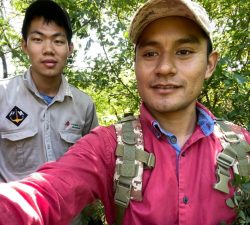
The rationale. The disappearance or degradation of ecosystems seriously affects ecosystem services and functions. Productivity is a fundamental and important component of ecosystem functioning and continued loss of biodiversity is likely to lead to an accelerated decline in global forest productivity.
The aim. This study aimed to understand the relationship between biodiversity and productivity in a tropical dry forest in Mexico.
The approach. 8 biodiversity experiment sites were established in 2020 in Nizanda, Mexico. Each site consists of 4 25x25m plots: a control plot and three treatments plots, where 30% of the basal area of either dominant, rare or randomly species were removed. Woody individuals of at least 1 cm diameter at 30 cm height were tagged, identified to species level and measured.
Findings
- Absolute productivity over the two-year period (from 2020-2022) in all removal treatments were lower than the control treatment. Additionally, there is no significant difference in productivity between the dominant and rare species removal treatment.
- Relative productivity did not differ significantly between the treatment and control plots.
Implications
In an early successional dry tropical forest, no effect of dominant or rare species on productivity were found. This could be due to the fact that the experiment started two years ago and the removal effect is not yet detectable, or that it is not the species identity but rather the species traits which determine productivity.
Citation. Yiran Liu (2023) The effect of biodiversity on productivity in a Mexican tropical dry forest. MSc thesis, Wageningen University and Research, Wageningen, the Netherlands.
2022
Landscape effects on early secondary forest succession in Nizanda, Mexico Jules Koppen
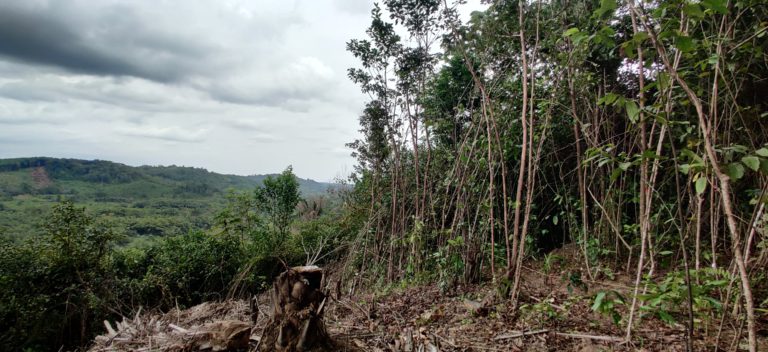

The rationale. Agricultural expansion is a main cause of tropical deforestation, with loss of biodiversity and ecosystem services and increased global carbon emissions as a result. With the abandonment of the agricultural fields, secondary succession is allowed to set in, forming secondary forests through natural regeneration. These tropical secondary forests are valuable as a carbon sink, but may also aid in biodiversity recovery and ecosystem provisioning. Secondary succession is thought to be driven by the land-use history, but it is also influenced by the landscape context: the structure and composition of the surrounding landscape that provide seed sources and habitat for dispersal agents. Discovering the effects of the surrounding landscape on forest recovery may grant a valuable insight for restoration purposes.
Aims. The aim of this research is to identify the landscape attributes that affect secondary tropical dry forest regeneration after land abandonment.
Approach. Fourteen 25 x 25 m plots were established on recently abandoned pastures and crop fields along a surrounding forest cover gradient (0-100%). Data on woody and herbaceous vegetation was gathered using a stratified plot design. Land cover types including old secondary forest (OSF, 25+ years old) and intermediate-aged secondary forest (ISF, 25 to 11 years old) in a circle of 100m and 1200m radius around the focal plots.
Findings.
- Intermediate-aged forests in the direct proximity pre-eminently affected the recovery of secondary tropical forest during the first year of succession, enhancing forest structure, increasing LAI and constituting successional shifts towards pioneer tree dominated stages.
- Contrastingly, old-aged forests negatively influenced the recovery of forest diversity.
- Landscape attributes at larger spatial scales (up to 1200 m) are less important perhaps, because dry forests are dominated by wind-dispersed trees, and less on animals that need surrounding habitat.
Implications. This research indicates that natural regeneration can be a viable method of forest restoration, with secondary forest in the direct neighbourhood serving seed source and as adequate disperser habitat. Future restoration projects should not only focus on preserving mature forests, but should also consider mid-aged secondary forests for restoration efforts
Citation. Jules Koppen (2022) Landscape effects on early secondary forest succession in Nizanda, Mexico. MSc thesis, Wageningen University and Research, Wageningen, the Netherlands.
Jules Koppen graduated in Forest and Nature Conservation with the Management track. He now works as a project coordinator at IUCN NL.
Land use history drives early secondary succession in a Mexican tropical dry forest Robyn Jansma
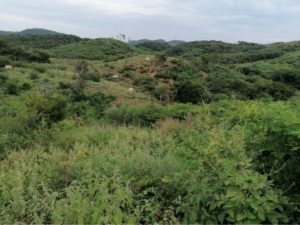

The rationale. Abandonment of agricultural and pastoral lands leads to the emergence of young, secondary forests in the tropics. The land use history generates variation in forest recovery and therefore to the ecosystem services these regrowing forests provide, such as carbon sequestration or biodiversity conservation. The first years of succession are the foundation for the subsequent successional developments and it is essential to uncover how land use prior to abandonment affects early forest succession.
The aim. This research evaluates how management practices during agricultural and pastoral use affect subsequent secondary forest recovery on abandoned fields in a tropical dry forest in Southern Mexico.
The approach. Semi-structured interviews with farmers and landowners were conducted to define each site’s land use history. In 14 abandoned agricultural plots trees and different growth forms were measured for their size and identified to species. 13 Forest recovery attributes were assessed related to growth form composition, forest structure and diversity, to find potential relationships between land use history and forest recovery.
Findings.
- The use of heavy machinery increases herb cover but reduces tree cover, forest structure, and tree diversity, probably through destruction of regenerative legacies and soil compaction.
- Past fire events reduce the relative abundance and density of trees only, likely through destruction of seeds, buds and resprouts and reduced soil nutrients.
- Dual land use (i.e., the combination of crop cultivation and pasture), is surprisingly advantageous for the recovery of the vegetation cover and LAI as compared to single use (crop cultivation only) as it harbors more remnant vegetation at the time of abandonment.
- Longer fallow periods stimulate the recovery of tree and seedling diversity, potentially because those sites are surrounded by relatively more mature forest.
- Finally, variation in soil conditions has little to no effect on forest recovery.
Implications. The use of heavy machinery is the most influential management practice, affecting almost all forest attributes negatively. When natural forest regrowth is intended after land use, then farmers are advised to constrain from using machinery as far as possible and feasible. With the eye on natural regeneration, dual land use proves a tenable practice and burning is potentially a tolerable alternative for land clearing instead of using machinery. The incorporation of fallow periods is beneficial for recovery of forest diversity and should be encouraged. The previous application of these practices can serve as proxies in nature restoration efforts to identify those abandoned sites where assisted natural regeneration is needed.
Citation. Robyn Jansma (2022). Land use history drives early secondary succession in a Mexican tropical dry forest. MSc thesis, Wageningen University & Research, Wageningen, The Netherlands.
P.S. Due to covid-19, my fieldwork could not be conducted in Mexico. Luckily, I got the chance to perform similar research in Ghana, which resulted in the most amazing and educational experience.
Understory plant dynamics during tropical dry forest succession in Ghana Miho Tsujii

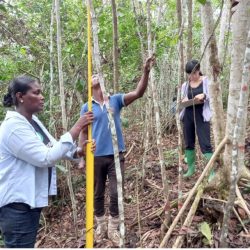
The rationale. The area of tropical dry forests is decreasing rapidly because of land use conversion, but forests have also the potential to regrow naturally on abandoned lands. The secondary succession starts with the regeneration of tree seedlings and the pathway of succession is determined by three interlinked factors (stand age, stand structure, and environment).
The aim. This study aimed to get a mechanistic understanding of secondary succession by analysing 1) how does stand structure changes with time, 2) how changes in stand structure affect understory environment, and 3) how changes in environment drive plant regeneration.
The approach. In 19 plots aged from 0 to 6 years, stand structure (basal area, height variation, and crown area) and regeneration factors (growth form composition and seedling diversity) were measured. In each plot, a sensor was established to record temperature and soil humidity. Soil samples were taken to quantify bulk density and soil fertility. Light intensity was measured at 1 m above ground in each plot.
Findings
- Forest structure increased linearly with time probably because the forests are in a young development stage and established trees grew continuously.
- Increase in forest structure led to a darker and cooler understory microclimate and wetter soil probably due to more leaf mass and more light absorption by leaves.
- Only soil phosphorus concentration among other nutrients decreased with the development of forest structure potentially due to the uptake by regrowing plants and immobilization.
- The decrease in the proportion of herbaceous species was led by the decline in light and soil fertility as herbaceous species are usually short-lived and more light- and nutrient- demanding compared to woody species.
- Changes in environmental conditions did not influence tree seedling diversity potentially because dispersal limitation was a stronger determinant of seedling diversity.
Implications
Because the establishment of forests in the early stage occurs rapidly and trees can outcompete herbaceous species along with the change in environment, nature-based forest restoration can be carried out. The change in soil factors and seedling diversity was not driven by the change in stand structure or microclimate and is supposed to proceed rather slowly. Therefore we should assist the natural regeneration by ensuring there is sufficient forests nearby that provide seed and seed dispersal agents.
Citation. Miho Tsujii (2022). Understory plant dynamics during tropical dry forest succession in Ghana. MSc thesis, Wageningen University & Research, Wageningen, The Netherlands.
2020
Functional traits reveal how pioneer tree species cope with drought
Coen van den Brand
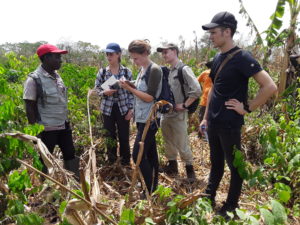
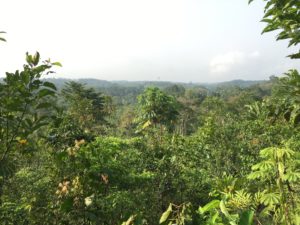
The rationale. Pioneers are the first plant species to establish during forest succession. By forming a first canopy layer they improve microclimatic conditions, thus paving the way for the establishment of other species. It is not clear how pioneers are able to cope with the extremely hot and dry environmental conditions. A clue may be find in their hydraulic traits; how do plants take up, transport, and use water? Insights into hydraulic traits may allow to better understand under what conditions pioneers are able to establish, and to improve species selection for restoration activities.
Aims. This study aimed to understand how pioneer species from dry and wet tropical forests differ in their hydraulic traits.
Approach. Seventeen stem and leaf traits were collected for 10 pioneer species from dry forest and 8 pioneer species from wet forest in Ghana.
Findings
- Dry forest species were more drought tolerant than wet forest species; they had a more negative leaf water potential, which allows them to continue leaf functioning during drought stress.
- Dry forest species had a higher wood density which ensures hydraulic safety and continued water transport during drought. They also had higher leaf phosphorus concentration which may increase photosynthesis.
- Wet forest species had a larger leaf stomatal area which allows them to transpire more water, that is in abundant supply.
- Across species, drought tolerance (i.e., a high absolute leaf water potential) was positively correlated with wood density and negatively with leaf area and stomatal leaf area, indicating a continuum in drought strategies.
Implications. Tropical pioneer species and secondary succession may help to restore landscapes naturally and combat climate change. To enhance the success of restoration programs in dry environments, drought tolerant species can be selected that have a high wood density and a high absolute leaf water potential.
Citation. Coen van den Brand (2020) Tropical pioneer species show a drought tolerance gradient and differ in hydraulic traits. MSc thesis, Wageningen University and Research, Wageningen, the Netherlands
Coen van den Brand graduated in Forest and Nature Conservation. He is interested in restoration of tropical forest landscapes, co-organized the FEM restoration sessions, and currently works as a forestry consultant.
How do functional traits differ amongst secondary forest species?
Edoardo Nevola
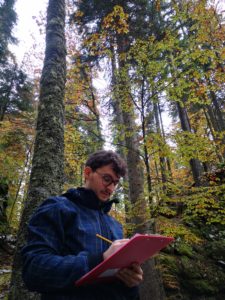
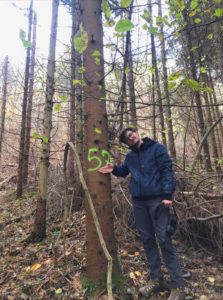
Why traits? Plant species differ tremendously in their characteristics (i.e., ‘traits’). To design efficient forest restoration strategies, insight is needed how species vary in their traits, and how that allows them to become successful in a specific environment.
The aims. This study aimed to evaluate how functional traits of secondary tree species differ between ecological groups related to successional stage (early vs. late), forest type (dry vs. wet), adult stature (small vs. large), life form (shrubs vs. trees) and origin (exotic vs. native).
The approach. 11 leaf-, stem- root- and reproductive traits were compiled for 392 tropical secondary forest species from Queensland, Australia.
Findings
- Late-successional species and exotic species had larger animal-dispersed seeds and therefore a better establishment success than early-successional species and native species.
- Trees and wet forest species had larger leaves, fruits and seeds and lower wood density than shrubs and dry forest species.
- A principal component analysis revealed two plant strategy axes; 1) a reproductive axis reflecting a trade-off between small-seeded species with high colonization potential and large-seeded species with high establishment success, and 2) an economic axis reflecting a trade-off between dense-wooded evergreen species and soft-wooded deciduous species that can avoid drought.
Implications. To increase the diversity and resilience of restored forests, a mix of species with different trait values could be selected for mixed species plantings. Native and pioneer species have widely shown to be successful in forest restoration. If carefully selected, additionally species with different traits values can be included, such as late-successional species or exotic species. Late-successional and exotic species have larger seeds, and therefore a larger establishment success than native and early-successional species. At the same time they can bring several benefits to the ecosystem. Because of their fleshy seeds they can attract frugivore seed dispersers. They can shade out herbaceous weeds, may act as nurse trees for the establishment of other species, and provide forest products and resilience to environmental change.
Citation. Eduardo Nevola (2020) How do functional traits differ amongst tropical secondary forest species? MSc thesis, Wageningen University and Research, Wageningen, the Netherlands.
Edoardo Nevola graduated in Forest and Nature Conservation from WUR. He is interested in forest ecology, and is currently working at the University of Milan on forest carbon storage.
MSc thesis (Ongoing)
Are hydraulic strategies of tropical forest trees globally determined by climate or soil properties?
Annabel Isarin
The rationale. Human-induced climate change has increased the frequency and intensity of droughts worldwide. This may increase tree mortality and affect species distribution and diversity, both in dry and wet tropical forests. Therefore, there is an increased need to better understand the hydraulics and drought responses of tropical forests. Hydraulic strategies, characterized by different hydraulic functional traits, determine tree water use and drought resistance. Species may be either hydraulically efficient, or hydraulically safe, due to a tradeoff between a high xylem conductance and cavitation resistance. Furthermore, species may be drought tolerant, characterized by a low turgor loss point, or drought avoidant through shedding their leaves during the dry season. These hydraulic strategies have been found to be driven by differences in precipitation. However, recent research revealed high cavitation resistance to be associated with a low soil phosphorus content. This suggests that hydraulic strategies might have evolved to tolerate harsh growing conditions in general.
Aims. My research is aimed to find out how hydraulic strategies are determined by climate and soil properties.
Approach. My approach is to create an extensive database from several hydraulic traits of trees across the pantropics, focusing on the cavitation resistance (P50) and the turgor loss point (Ψtlp), by collecting available data from published studies. Climatic variables and soil properties are largely gathered from global databases.
Implications. This study will contribute to understanding the complex interactions between the climate, soil properties and tropical tree hydraulics, which is essential for conservation and restoration of tropical forests worldwide.
